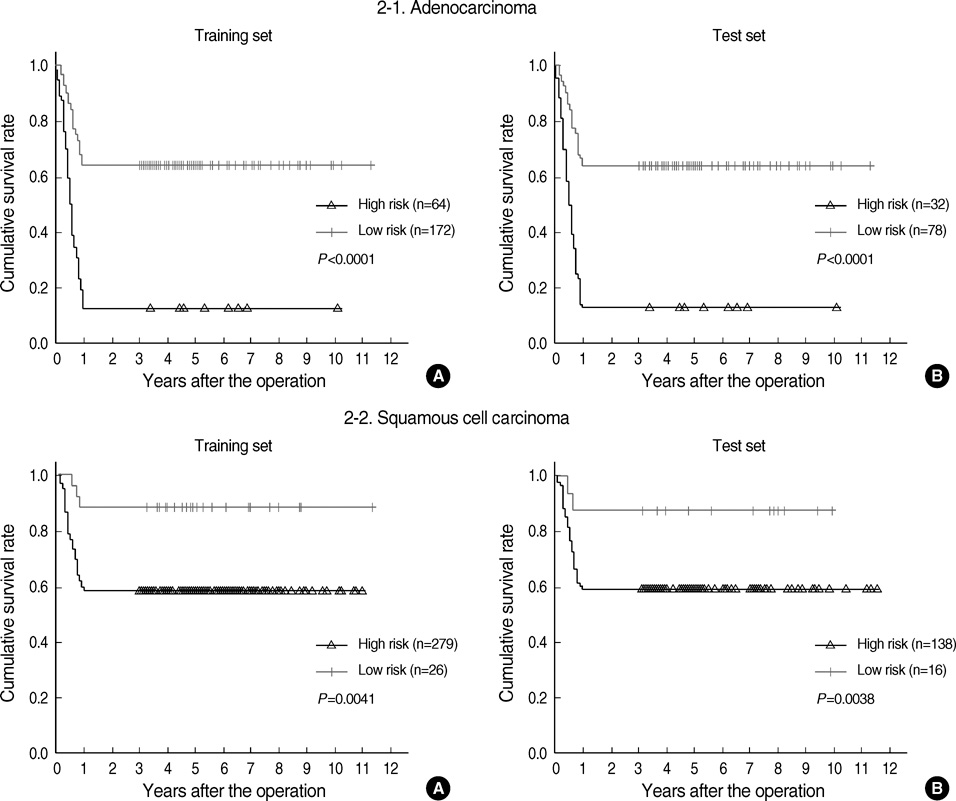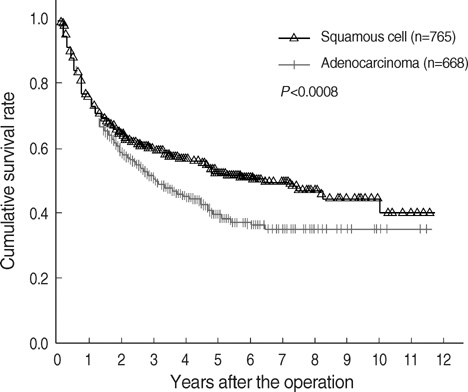J Korean Med Sci.
2009 Oct;24(5):824-830. 10.3346/jkms.2009.24.5.824.
Predicting Recurrence Using the Clinical Factors of Patients with Non-small Cell Lung Cancer After Curative Resection
- Affiliations
-
- 1Department of Thoracic Surgery, Asan Medical Center, University of Ulsan College of Medicine, Seoul, Korea.
- 2Department of Thoracic Surgery, Samsung Medical Center, Sungkyunkwan University School of Medicine, Seoul, Korea. jkimsmc@skku.edu
- 3Cancer Research Division, Center for Clinical Research, Samsung Biomedical Research Institute, Seoul, Korea.
- KMID: 1782001
- DOI: http://doi.org/10.3346/jkms.2009.24.5.824
Abstract
- We present a recurrence prediction model using multiple clinical parameters in patients surgically treated for non-small cell lung cancer. Among 1,578 lung cancer patients who underwent complete resection, we compared the early-recurrence group with the 3-yr non-recurrence group for evaluating those factors that influence early recurrence within one year after surgery. Adenocarcinoma and squamous cell carcinoma were analyzed independently. We used multiple logistic regression analysis to identify the independent clinical predictors of recurrence and Cox's proportional hazard regression method to develop a clinical prediction model. We randomly divided our patients into the training and test subsets. The pathologic stages, tumor cell type, differentiation of tumor, neoadjuvant therapy and age were significant factors on the multivariable analysis. We constructed the model for the training set with adenocarcinoma (n=236) and squamous cell carcinoma (n=305), and we applied it to the test set with adenocarcinoma (n=110) and squamous cell carcinoma (n=154). It was predictive for the in adenocarcinoma (P<0.001) and the squamous cell carcinoma (P=0.037), respectively. Our results showed that our recurrence prediction model based on the clinical parameters could significantly predict the individual patients who were at high risk or low risk for recurrence.
MeSH Terms
-
Adenocarcinoma/mortality/pathology/surgery
Adolescent
Adult
Aged
Aged, 80 and over
Carcinoma, Non-Small-Cell Lung/mortality/pathology/*surgery
Carcinoma, Squamous Cell/mortality/pathology/surgery
Disease-Free Survival
Female
Humans
Lung Neoplasms/mortality/pathology/*surgery
Male
Middle Aged
Neoplasm Recurrence, Local/*diagnosis
Neoplasm Staging
Predictive Value of Tests
Prognosis
Regression Analysis
Risk Factors
Survival Rate
Figure
Reference
-
1. Bennett WP, Hussain SP, Vahakangas KH, Khan MA, Shields PG, Harris CC. Molecular epidemiology of human cancer risk: gene-environment interactions and p53 mutation spectrum in human lung cancer. J Pathol. 1999. 187:8–18.2. Mountain CF. Revisions in the international system for staging lung cancer. Chest. 1997. 111:1710–1717.
Article3. Nesbitt JC, Putnam JB Jr, Walsh GL, Roth JA, Mountain CF. Survival in early-stage non-small cell lung cancer. Ann Thorac Surg. 1995. 60:466–472.
Article4. Park I, Kim DJ, Chung KY, Kim KD, Joo HC. Risk factors for recurrence in completely resected pT1/2N1 non-samll cell lung cancer. Korean J Thorac Cardiovasc Surg. 2005. 38:421–427.5. Arriagada R, Bergman B, Dunant A, Le Chevalier T, Pignon JP, Vansteenkiste J. Cisplatin-based adjuvant chemotherapy in patients with completely resected non-small-cell lung cancer. N Engl J Med. 2004. 350:351–360.
Article6. Winton T, Livingston R, Johnson D, Rigas J, Johnston M, Butts C, Cormier Y, Goss G, Inculet R, Vallieres E, Fry W, Bethune D, Ayoub J, Ding K, Seymour L, Graham B, Tsao MS, Gandara D, Kesler K, Demmy T, Shepherd F. Vinorelbine plus cisplatin vs. observation in resected non-small-cell lung cancer. N Engl J Med. 2005. 352:2589–2597.
Article7. Brundage MD, Davies D, Mackillop WJ. Prognostic factors in non-small cell lung cancer: a decade of progress. Chest. 2002. 122:1037–1057.8. Potti A, Mukherjee S, Petersen R, Dressman HK, Bild A, Koontz J, Kratzke R, Watson MA, Kelley M, Ginsburg GS, West M, Harpole DH Jr, Nevins JR. A genomic strategy to refine prognosis in early-stage non-small-cell lung cancer. N Engl J Med. 2006. 355:570–580.
Article9. Pfannschmidt J, Muley T, Bulzebruck H, Hoffmann H, Dienemann H. Prognostic assessment after surgical resection for non-small cell lung cancer: experiences in 2083 patients. Lung Cancer. 2007. 55:371–377.
Article10. Abel U, Berger J, Wiebelt H. CRITLEVEL: an exploratory procedure for the evaluation of quantitative prognostic factors. Methods Inf Med. 1984. 23:154–156.
Article11. Birim O, Kappetein AP, Waleboer M, Puvimanasinghe JP, Eijkemans MJ, Steyerberg EW, Versteegh MI, Bogers AJ. Long-term survival after non-small cell lung cancer surgery: development and validation of a prognostic model with a preoperative and postoperative mode. J Thorac Cardiovasc Surg. 2006. 132:491–498.
Article12. Harpole DH Jr. Prognostic modeling in early stage lung cancer: an evolving process from histopathology to genomics. Thorac Surg Clin. 2007. 17:167–173.
Article13. Padilla J, Calvo V, Penalver JC, Zarza AG, Pastor J, Blasco E, Paris F. Survival and risk model for stage IB non-small cell lung cancer. Lung Cancer. 2002. 36:43–48.
Article14. Charloux A, Hedelin G, Dietemann A, Ifoundza T, Roeslin N, Pauli G, Quoix E. Prognostic value of histology in patients with non-small cell lung cancer. Lung Cancer. 1997. 17:123–134.
Article15. Khan OA, Fitzgerald JJ, Field ML, Soomro I, Beggs FD, Morgan WE, Duffy JP. Histological determinants of survival in completely resected T1-2N1M0 nonsmall cell cancer of the lung. Ann Thorac Surg. 2004. 77:1173–1178.
Article16. Okamoto T, Maruyama R, Suemitsu R, Aoki Y, Wataya H, Kojo M, Ichinose Y. Prognostic value of the histological subtype in completely resected non-small cell lung cancer. Interact Cardiovasc Thorac Surg. 2006. 5:362–366.
Article17. Yokouchi H, Kodama K, Higashiyama M, Takami K. Prognostic assessment of resected lung cancer based on the new international staging system: analysis by histologic types. Kyobu Geka. 2000. 53:899–904.
- Full Text Links
- Actions
-
Cited
- CITED
-
- Close
- Share
- Similar articles
-
- Lobectomy versus Sublobar Resection in Non-Lepidic Small-Sized Non-Small Cell Lung Cancer
- Adjuvant Chemotherapy in Non-Small Cell Lung Cancer
- Cell Differentiation Might Predict the Recurrence in Surgically Resected Non-Small Cell Lung Carcinoma
- Pattern of Recurrence after Curative Resection of Local (Stage I and II) Non-Small Cell Lung Cancer: Difference According to the Histologic Type
- The Prognosis following Radiation Therapy or Surgical Resection for Stage 1 Non-Small Cell Lung Cancer





